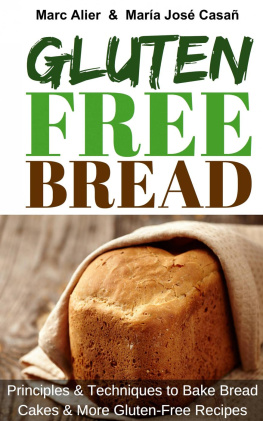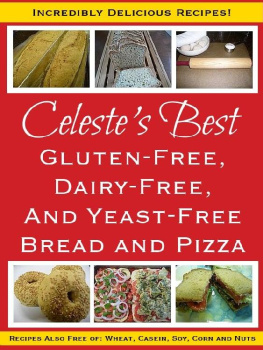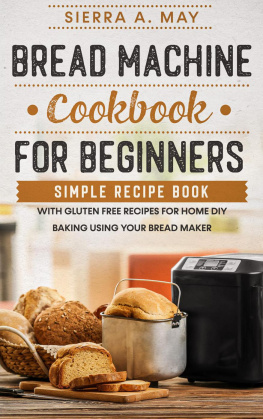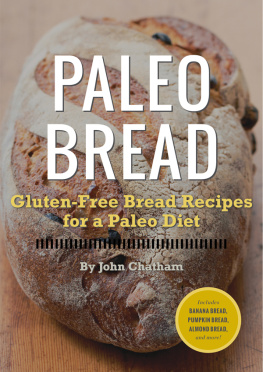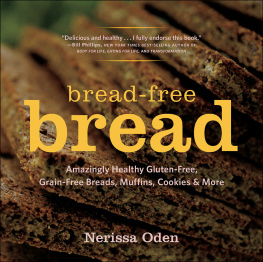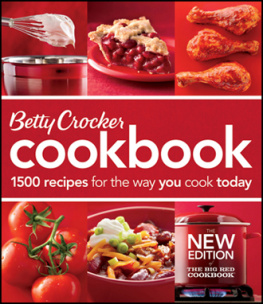Gluten-Free Bread
Marc Alier, Mara Jos Casa
Translated by Nadia Hleb
Gluten-Free Bread
Written By Marc Alier, Mara Jos Casa
Copyright 2016 Marc Alier / Mara Jos Casa
All rights reserved
Distributed by Babelcube, Inc.
www.babelcube.com
Translated by Nadia Hleb
Cover Design 2016 Marc Alier
Babelcube Books and Babelcube are trademarks of Babelcube Inc.
GLUTEN-FREE
BREAD
Principles, techniques and tricks to make bread and other gluten-free recipes.
Marc Alier & Mara Jos Casa
LEGAL NOTICE
(C)Marc Alier & Mara Jos Casa 2016
Translated by Nadia Hleb 2016.
All rights reserved.
C omplete or partial reproduction of the contents of this book without the explicit permission of the authors is prohibited.
Much effort has been made to ensure that the content of this book, at the time of publication, is correct and useful to readers. However, this is not an exhaustive look at the subjects studied. This book is ultimately a cookbook, not medical advice.
The authors are not responsible for any possible damage or losses due to the information provided in this book. The reader is responsible for his/her own choices, actions and results.
This book is not intended as a replacement for professional medical advice.
ACKNOWLEDGEMENTS
W e want to thank you for your support, help, distribution, advice and for trying our bread:
Valentina Guerrero, Inma and Marta Forment, Jos and Jose Casa, Dani Amo, Esther Sanchez, Dr. Lluisa Colomer M.D., Lluis Vidal, Toms Manzanares, Carles Cao, Enric Mayol, Saul Cheung, Zaira Guerrero, Miquel Barcel, Miguel Angel Conde, Nikolaos Galanis, Creu Rossell, Alfons Vials, Fernando Artal, Jordi Prats, David Sez, Carles and Teresa of Origen Ecolgic (Badalona), Mara of Diettica Colomer (Badalona), Marina of FreeFood (Barcelona), Lorena of Celicidad.net (Madrid), Josep Colonques of Evissalut.com (Ibiza), Miguel Suarez of Le Pain Traquile (Premi de Mar), Mery, Xavi and the Radio Andorra team and the listeners of the programs Zetatesters.com and Mossegalapoma.cat.
PREFACE
One day you or someone in your family may need to adopt a gluten-free diet. Theres nothing wrong with that. For someone sensitive or intolerant to gluten, switching to a gluten-free diet often leads to improvements in health, mood, and athletic and mental performance.
At home, our eating habits include bread, cookies, cakes, pastries, pizzas, etc. And while we could completely eliminate them from our diet, its not essential. If you like bread and pizza, theres nothing wrong with keeping them in your diet. As long as they are gluten free and nutritionally balanced.
Gluten-free products that we find in supermarkets and health food stores arent always nutritionally balanced. Sometimes starches, sugars, preservatives and other additives are overused to compensate for the lack of gluten.
For this reason we decided to make our breads, pastries and pizzas at home. This way, we make sure we understand the ingredients their origin and quality and we also know that what we put on the table is balanced in nutrients. But making gluten-free bread, without relying on commercial bread mixes, isnt easy.
To successfully adopt a gluten-free diet, one should be able to answer a series of questions at every step.
On one hand, this book tries to provide answers to the questions weve had along the way of adopting a gluten-free diet, and on the other hand, it presents our recipes for gluten-free breads, pizzas, cakes etc.
PROLOGUE
I recently read an interview of a pediatric gastroenterologist in Argentina who said that celiac disease is the illness that the whole world would choose if illnesses could be chosen. And the worst part of celiac disease and sensitivity to gluten is that you dont know you have it. I imagine that the authors of this book, as I experienced as a child, underwent many doctors trips in order to get a diagnosis. But once they tell you that youre celiac and after spending some time dedicated to reading and informing yourself about gluten, your disease and gluten-free diet, your life changes. After a few months without gluten, and any kind of medicine, you recover your health, wellbeing, happiness and desire to do things. Thats why, explains the Argentine doctor, if somebody tells you to develop a disease, celiac disease is the lesser evil, as long as were responsible about it.
I was diagnosed at 14 years old, in 1997. I had always been a girl who grew slower than average, with low weight. I frequently experienced mood swings and regular episodes of diarrhea and bad spells. On top of this, I had constant anemia and a super swollen belly. Despite having classic and clear symptoms, in those times the idea of celiac disease only existed for young children, and if they hadnt diagnosed me so early, it would have been crazy to think it was celiac disease.
Luckily, I meet a young pediatrician fresh out of college who saw what others didnt see. An analysis and later a biopsy confirmed the diagnosis, and the world came crashing down on my parents. We lived in a town that over the years has become the place with the most celiacs in Spain, Cangas del Narcea, with 3% of the population affected. But at the time nobody had heard of celiac disease and only we knew that I couldnt eat cake, pizza, rolls, pasta and bread. Bread!!
And how would I feed myself without bread? I loved bread, adored bread. My mother always said that she raised me on a diet based on steak, fries and Nutella sandwiches, because they were the only things that I liked and wanted to eat. I remember twice a week the local baker of Cangas left his village to sell loaves of bread, Tuesdays and Thursdays, which of course were my favorite days. My mother gave me 275 pesetas and I bought a super crispy loaf with a delicious center that I ate with a healthy dose of Nutella. I still remember the taste, I still remember how the crust crunched and the still-hot center mixed with the chocolate. Its one of those happy memories of childhood.
Until I was 14, of course. In addition to giving up Castros bread (the bakers), I also had to give up the French toast that my father made me for breakfast every Saturday, and the brochette that I ate at recess at school. Of course celiac disease requires completely eliminating gluten, strictly and for your entire life, but at the time and with so little information, we only knew four basic aspects about a gluten-free diet and for me the most important and problematic one was bread.
Since the Association of Celiacs of Asturias[i] gave us more information on gluten and a gluten-free diet, we began another fight, because it turns out that gluten is everywhere, but thats a story for another day.
The first gluten-free bread that I tried made me cry. It wasnt a matter of the brand, although certainly this particular one still exists and charges outrageous prices for what they call bread. It was a product of poor quality in terms of taste, texture, and worst of all, in nutritional properties.
For years, many years, I gave up eating bread. Yes, yes, that staple of the food pyramid together with the consumption of other grains and tubers contribute to nearly half the daily energy we need. There wasnt any bread on the market worthwhile. And my mother, who was also celiac as she discovered some months after me, started to make bread at home. But in those years flour and other gluten-free products did not allow the making of quality bread even if they were baked with the loving hands of a mother.
Many years passed until decent bread started to arrive on the market, breads that had to be baked and eaten in five minutes because they became hard as stones, or just looking at them made them crumble. But eaten quickly or once in a while, they werent entirely bad.
Next page
